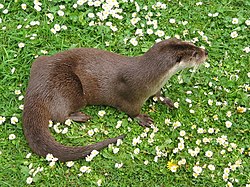Lutra
| Lutra | |
|---|---|

| |
| Lutra lutra | |
| Scientific classification | |
| Kingdom: | Animalia |
| Phylum: | Chordata |
| Class: | Mammalia |
| Order: | Carnivora |
| Family: | Mustelidae |
| Subfamily: | Lutrinae |
| Genus: | ''Lutra'' Brünnich, 1771 |
| Species | |

| |
| Lutra ranges | |
Lutra is a genus of otters. It is one of seven in the subfamily Lutrinae.
Taxonomy and evolution
[edit]The genus includes the following living species:
- Lutra lutra – European otter
- Lutra sumatrana – hairy-nosed otter
- Lutra nippon – Japanese otter - recently extinct
The genus most likely evolved in Asia during the late Pliocene epoch;[1] the oldest fossil belonging to the genus is of the species Lutra palaeindica, and dates from the late Pliocene.[2]
Habitat
[edit]Lutra species are semiaquatic mammals, so are well-adapted to both water and land. They prefer shallow, narrow areas of streams surrounded by mature trees and with rocks, especially where weirs reduce the flow of the water, as well as attract fishes. They seem to tolerate roads, residential and agricultural areas, but only moderate human interaction. They clearly avoid areas without vegetation cover and rocks.[3]
Diet
[edit]The otters' diets consist mainly of fish (hence, the aquatic environment). However, during the winter and in colder environments, fish consumption is significantly lower and the otters use other resources for their food supply. Their diets can consist of amphibians (mainly frogs and pond turtles), bird predation (mainly anserine species), small rodents, and invertebrates such as water beetles, snails and crayfish. They have also feed on plants, specifically grasses. With this large diversity of prey and resources for their diets, otters are considered "opportunistic eaters".[4]
Behavior
[edit]Some otters live in solitude (away from other otters), while others live in groups.
References
[edit]- ^ Koepfli, K-P.; et al. (2008). "Multigene phylogeny of the Mustelidae: Resolving relationships, tempo and biogeographic history of a mammalian adaptive radiation". BMC Biology. 6 (10). doi:10.1186/1741-7007-6-10. PMC 2276185. PMID 18275614.
{{cite journal}}: Explicit use of et al. in:|author=(help)CS1 maint: unflagged free DOI (link) - ^ Larivière, S. (2002). "Lutra maculicollis". Mammalian Species: Number 712: pp. 1–6. doi:10.1644/1545-1410(2002)712<0001:LM>2.0.CO;2.
- ^ Cho, Hee-Sun; Choi, Kwang-Hee; Lee, Sang-Don; Park, Young-Seuk (2009). "Characterizing habitat preference of Eurasian river otter (Lutra lutra) in streams using a self-organizing map". Limnology. 10 (3): 203. doi:10.1007/s10201-009-0275-7.
- ^ Lanszki, József, Molnár, M. and Molnár, T. (2006). "Factors affecting the predation of otter (Lutra lutra) on European pond turtle (Emys orbicularis)". Journal of Zoology. 270 (2): 219. doi:10.1111/j.1469-7998.2006.00132.x.
{{cite journal}}: CS1 maint: multiple names: authors list (link)
